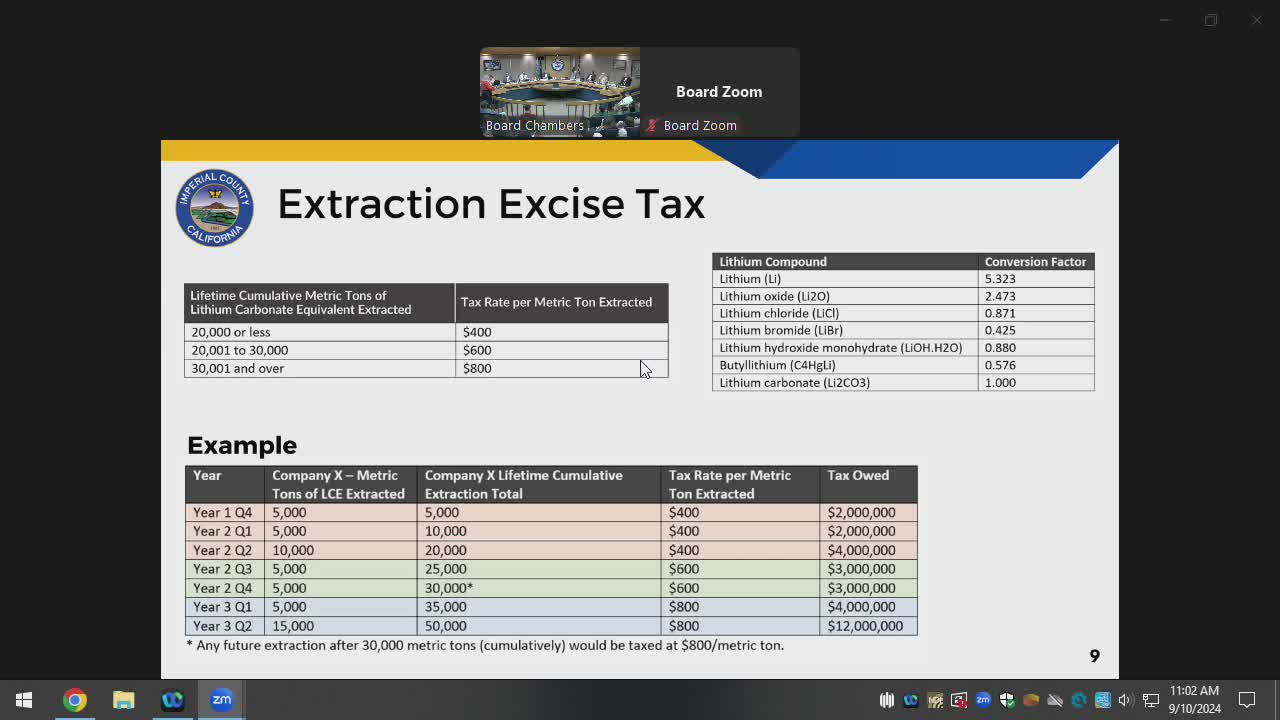Imperial County outlines ambitious lithium tax funding plan
September 10, 2024 | Imperial County, California
This article was created by AI summarizing key points discussed. AI makes mistakes, so for full details and context, please refer to the video of the full meeting. Please report any errors so we can fix them. Report an error »

In a recent government meeting, officials discussed the allocation of funds generated from a proposed lithium extraction tax, emphasizing the distribution of resources between the Salton Sea Restoration Fund and the County of Imperial. The tax structure, which varies based on the amount of lithium extracted, is designed to benefit both directly and indirectly affected communities.
The meeting highlighted that 20% of the tax revenue will be directed to the Salton Sea Restoration Fund, managed by the California State Director of Fish and Wildlife. However, as of August 2024, no specific plan has been released by the state regarding the utilization of these funds. Attendees were encouraged to direct inquiries about the fund's use to the appropriate state organization, as the County of Imperial will not oversee these allocations.
The remaining 80% of the tax revenue will be distributed within the County of Imperial, with a focus on communities impacted by lithium extraction. The county has included the Torres Martinez and Kishan tribes in its list of affected communities, acknowledging their reservations within the county. This decision aligns with the provisions of Senate Bill 125, which allows for the inclusion of additional communities beyond those explicitly listed in the legislation.
The development of the funding plan has been a collaborative effort, beginning with community discussions in June 2021. Over 150 public comments were collected during various listening sessions held throughout 2023, reflecting community desires for the benefits derived from the lithium tax. The proposed funding plan outlines that 15% of the revenue will go to directly affected communities, another 15% to all affected communities, and 10% will be allocated to a lithium community benefits program.
The meeting also provided a financial example based on an extraction of 20,000 metric tons of lithium, projecting a total revenue of $8 million, with $1.6 million earmarked for the Salton Sea Restoration Fund and $6.4 million for the County of Imperial. The tax rates will adjust based on the volume of lithium extracted, with higher rates applied to companies exceeding certain thresholds.
Overall, the discussions underscored the importance of community engagement in shaping the funding plan and the commitment to ensuring that the benefits of lithium extraction are equitably distributed among affected populations in Imperial County.
The meeting highlighted that 20% of the tax revenue will be directed to the Salton Sea Restoration Fund, managed by the California State Director of Fish and Wildlife. However, as of August 2024, no specific plan has been released by the state regarding the utilization of these funds. Attendees were encouraged to direct inquiries about the fund's use to the appropriate state organization, as the County of Imperial will not oversee these allocations.
The remaining 80% of the tax revenue will be distributed within the County of Imperial, with a focus on communities impacted by lithium extraction. The county has included the Torres Martinez and Kishan tribes in its list of affected communities, acknowledging their reservations within the county. This decision aligns with the provisions of Senate Bill 125, which allows for the inclusion of additional communities beyond those explicitly listed in the legislation.
The development of the funding plan has been a collaborative effort, beginning with community discussions in June 2021. Over 150 public comments were collected during various listening sessions held throughout 2023, reflecting community desires for the benefits derived from the lithium tax. The proposed funding plan outlines that 15% of the revenue will go to directly affected communities, another 15% to all affected communities, and 10% will be allocated to a lithium community benefits program.
The meeting also provided a financial example based on an extraction of 20,000 metric tons of lithium, projecting a total revenue of $8 million, with $1.6 million earmarked for the Salton Sea Restoration Fund and $6.4 million for the County of Imperial. The tax rates will adjust based on the volume of lithium extracted, with higher rates applied to companies exceeding certain thresholds.
Overall, the discussions underscored the importance of community engagement in shaping the funding plan and the commitment to ensuring that the benefits of lithium extraction are equitably distributed among affected populations in Imperial County.
View full meeting
This article is based on a recent meeting—watch the full video and explore the complete transcript for deeper insights into the discussion.
View full meeting
